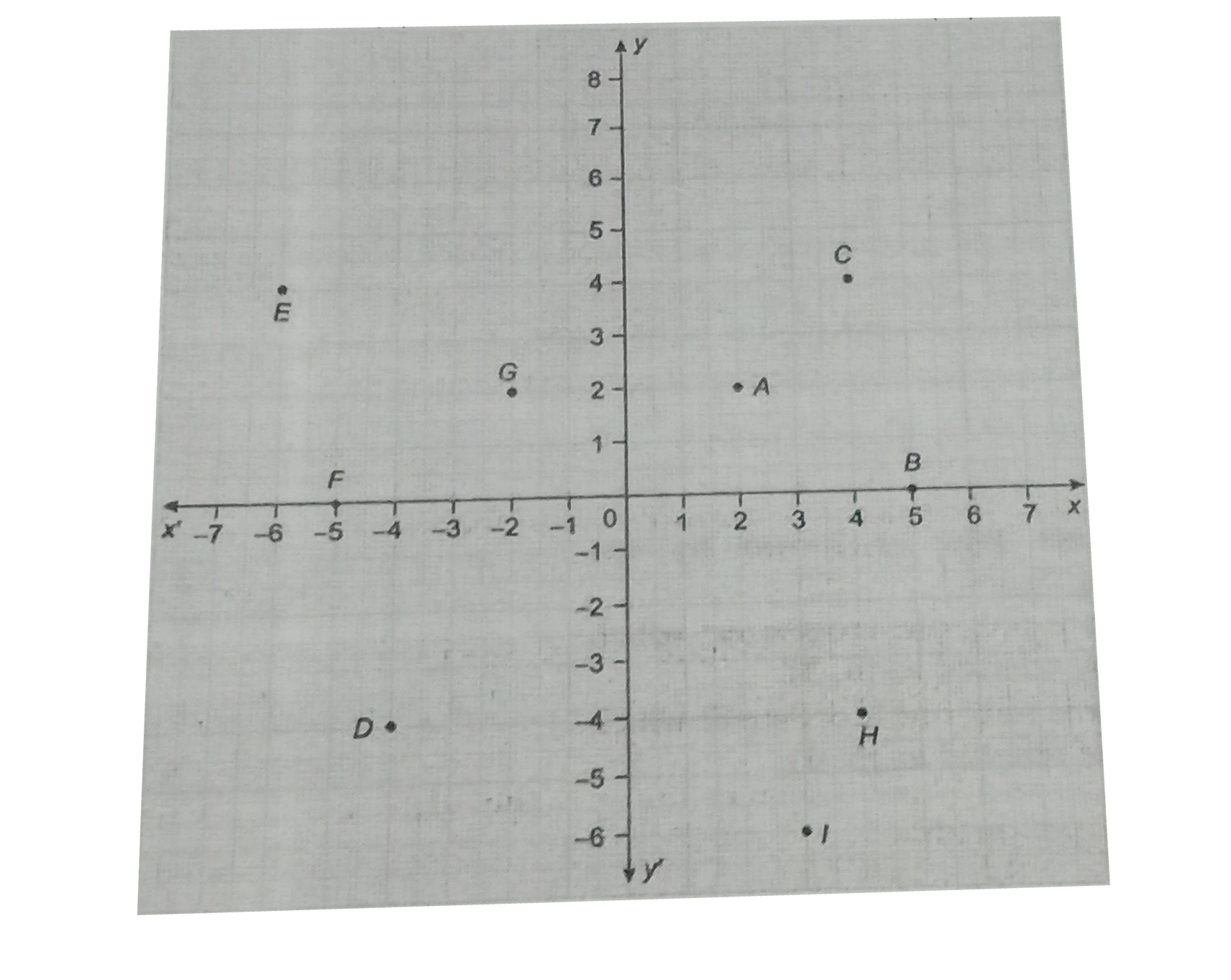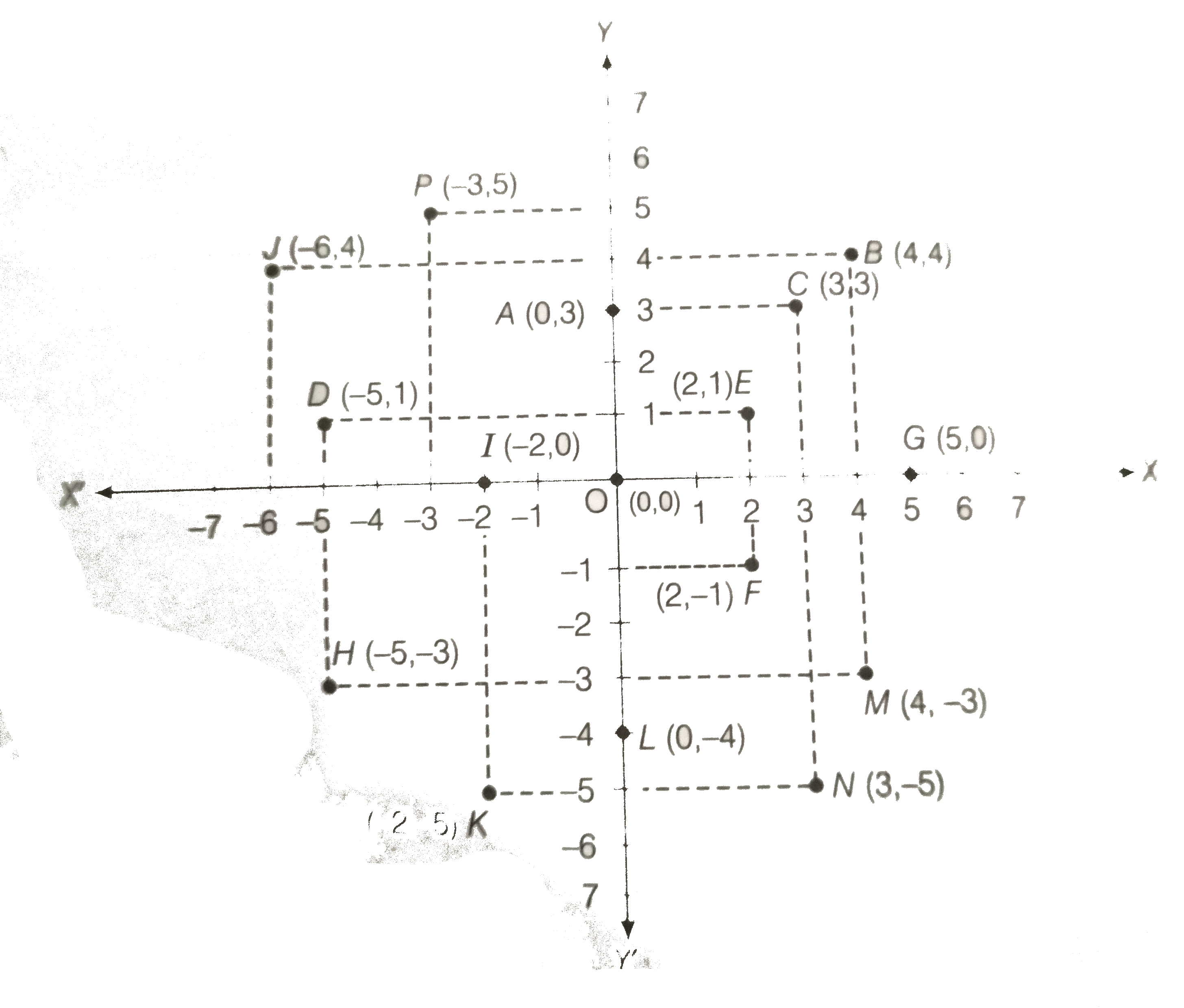Without plotting the points indicate the quadrant in which they will lie, if
(i) ordinate is 5 and abscissa is -3.
(ii) abscissa is -5 and ordinate is -3.
(iii) abscissa is -5 and ordinate is 3 .
(iv) ordinate is 5 and abscissa is 3.
To determine the quadrant in which each point lies based on the given abscissa (x-coordinate) and ordinate (y-coordinate), we can follow these steps:
Step 1: Understand the Quadrants
The Cartesian plane is divided into four quadrants:
- Quadrant I: x > 0 and y > 0 (both coordinates are positive)
- Quadrant II: x < 0 and y > 0 (x is negative, y is positive)
- Quadrant III: x < 0 and y < 0 (both coordinates are negative)
- Quadrant IV: x > 0 and y < 0 (x is positive, y is negative)
Step 2: Analyze Each Point
(i) Ordinate is 5 and abscissa is -3:
- Here, x = -3 (negative) and y = 5 (positive).
- Since x is negative and y is positive, this point lies in Quadrant II.
(ii) Abscissa is -5 and ordinate is -3:
- Here, x = -5 (negative) and y = -3 (negative).
- Since both x and y are negative, this point lies in Quadrant III.
(iii) Abscissa is -5 and ordinate is 3:
- Here, x = -5 (negative) and y = 3 (positive).
- Since x is negative and y is positive, this point lies in Quadrant II.
(iv) Ordinate is 5 and abscissa is 3:
- Here, x = 3 (positive) and y = 5 (positive).
- Since both x and y are positive, this point lies in Quadrant I.
Summary of Quadrants:
1. For ordinate 5 and abscissa -3: Quadrant II
2. For abscissa -5 and ordinate -3: Quadrant III
3. For abscissa -5 and ordinate 3: Quadrant II
4. For ordinate 5 and abscissa 3: Quadrant I
The Cartesian plane is divided into four quadrants:
- Quadrant I: x > 0 and y > 0 (both coordinates are positive)
- Quadrant II: x < 0 and y > 0 (x is negative, y is positive)
- Quadrant III: x < 0 and y < 0 (both coordinates are negative)
- Quadrant IV: x > 0 and y < 0 (x is positive, y is negative)
- Here, x = -3 (negative) and y = 5 (positive).
- Since x is negative and y is positive, this point lies in Quadrant II.
- Here, x = -5 (negative) and y = -3 (negative).
- Since both x and y are negative, this point lies in Quadrant III.
- Here, x = -5 (negative) and y = 3 (positive).
- Since x is negative and y is positive, this point lies in Quadrant II.
- Here, x = 3 (positive) and y = 5 (positive).
- Since both x and y are positive, this point lies in Quadrant I.
1. For ordinate 5 and abscissa -3: Quadrant II
2. For abscissa -5 and ordinate -3: Quadrant III
3. For abscissa -5 and ordinate 3: Quadrant II
4. For ordinate 5 and abscissa 3: Quadrant I
Topper's Solved these Questions
- COORDINATE GEOMETRYBOOK - NCERT EXEMPLAR ENGLISHCHAPTER - COORDINATE GEOMETRYEXERCISE - Exercise 3.4 Long Answer Type Questions
5 Videos
- COORDINATE GEOMETRYBOOK - NCERT EXEMPLAR ENGLISHCHAPTER - COORDINATE GEOMETRYEXERCISE - Exercise 3.2 Very Short Answer Type Questions
1 Video
- CONSTRUCTIONSBOOK - NCERT EXEMPLAR ENGLISHCHAPTER - CONSTRUCTIONSEXERCISE - Long Answer Type Questions
5 Videos
- HERON'S FORMULABOOK - NCERT EXEMPLAR ENGLISHCHAPTER - HERON'S FORMULAEXERCISE - Long Answer Type Questions
8 Videos
Similar Questions
A point whose abscissa is −3 and ordinate 2 lies in
View SolutionUse the given graph to find the co-ordinates of the points, satisfying the given condition.
(i) Whose abscissa is 2
(ii) Whose ordinates is 4
(iii) Whose abscissa is 5
(iv) Whose ordinates is -6
(v) Whose abscissa is -4
(vi) Whose abscissa is 4

View SolutionFor point (2, 14) find abscissa and ordinates. Also find distance from y and x-axis.
View SolutionUse the graph given along side, to find the co ordinates of the point (s) satisfying the given conditions:
(i) The abscissa is 2 (ii) The ordinate is 0 (iii) The ordinate is 3 (iv) The ordinate is 2 (v) The abscissa is 5 (vi) The abscissa is equal to the ordinate (vii) The ordinate is half of the abscissa

View SolutionThe points whose abscissa and ordinate have different signs will lie in
View SolutionWrite the linear equation such that each point on its graph has an ordinate 3 times its abscissa.
View SolutionFind the coordinates of the point
(i) which lies on X and Y-axes both.
(ii) whose ordinate is -4 and which lies on Y-axis.
(iii) whose abscissa is 5 and which lies on X-axis.
View SolutionA point on the curve y2=18x at which the ordinate increases at twice the rate of abscissa is
View SolutionFrom the given figure, answer the following questions

(i) Write the points whose abscissa is 0.
(ii) Write the points whose ordinate is 0.
(iii) Write the points whose abscissa is -5.
View SolutionFind the point on the curve y2= 8x. for which the abscissa and ordinate change at the same rate.
View Solution
